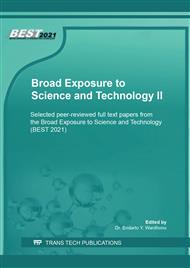[1]
M. T. Ismail and A. Bukhori, Consumer Perceptions of Sate Bandeng Attributes,, in 2nd and 3rd International Conference on Food Security Innovation (ICFSI 2018-2019), 2021, p.28–32.
DOI: 10.2991/absr.k.210304.006
Google Scholar
[2]
S. Malle, A. B. Tawali, M. M. Tahir, and M. Bilang, Nutrient composition of milkfish (Chanos chanos, Forskal) from Pangkep, South Sulawesi, Indonesia,, Journal of Nutrition, vol. 25, no. 1, p.155–162, (2019).
DOI: 10.31246/mjn-2018-0105
Google Scholar
[3]
M. Moditsi, A. Lazaridou, T. Moschakis, and C. G. Biliaderis, Modifying the physical properties of dairy protein films for controlled release of antifungal agents,, Food Hydrocolloids, vol. 39, p.195–203, (2014).
DOI: 10.1016/j.foodhyd.2014.01.011
Google Scholar
[4]
J. E. De La Torre Torres, F. Gassara, A. P. Kouassi, S. K. Brar, and K. Belkacemi, Spice use in food: properties and benefits.,, Critical Reviews in Food Science and Nutrition, vol. 57, no. 6, p.1078–1088, (2017).
DOI: 10.1080/10408398.2013.858235
Google Scholar
[5]
L. Atarés and A. Chiralt, Essential oils as additives in biodegradable films and coatings for active food packaging,, Trends in food science & technology, vol. 48, p.51–62, (2016).
DOI: 10.1016/j.tifs.2015.12.001
Google Scholar
[6]
S. Bhavaniramya, S. Vishnupriya, M. S. Al-Aboody, R. Vijayakumar, and D. Baskaran, Role of essential oils in food safety: Antimicrobial and antioxidant applications,, Grain & oil science and technology, vol. 2, no. 2, p.49–55, (2019).
DOI: 10.1016/j.gaost.2019.03.001
Google Scholar
[7]
N. Kanani, Rahmayetty, E. Y. Wardhono, and Wardalia, Preparation and characterization of blend film based on chitosan-poly lactic acid (PLA) composites,, in AIP Conference Proceedings, 2021, vol. 2370, no. 1, p.020026.
DOI: 10.1063/5.0062267
Google Scholar
[8]
A. Sionkowska, Current research on the blends of natural and synthetic polymers as new biomaterials,, Progress in polymer science, vol. 36, no. 9, p.1254–1276, (2011).
DOI: 10.1016/j.progpolymsci.2011.05.003
Google Scholar
[9]
L. Abugoch et al., Shelf-life of fresh blueberries coated with quinoa protein/chitosan/sunflower oil edible film,, Journal of the Science of Food and Agriculture, vol. 96, no. 2, p.619–626, (2016).
DOI: 10.1002/jsfa.7132
Google Scholar
[10]
I. Leceta, P. Guerrero, and K. De La Caba, Functional properties of chitosan-based films,, Carbohydrate polymers, vol. 93, no. 1, p.339–346, (2013).
DOI: 10.1016/j.carbpol.2012.04.031
Google Scholar
[11]
R. Parhi, Drug delivery applications of chitin and chitosan: a review,, Environmental Chemistry Letters, vol. 18, no. 3, p.577–594, (2020).
DOI: 10.1007/s10311-020-00963-5
Google Scholar
[12]
A. Alishahi et al., Chitosan nanoparticle to carry vitamin C through the gastrointestinal tract and induce the non-specific immunity system of rainbow trout (Oncorhynchus mykiss),, Carbohydrate polymers, vol. 86, no. 1, p.142–146, (2011).
DOI: 10.1016/j.carbpol.2011.04.028
Google Scholar
[13]
C. Qin, H. Li, Q. Xiao, Y. Liu, J. Zhu, and Y. Du, Water-solubility of chitosan and its antimicrobial activity,, Carbohydrate polymers, vol. 63, no. 3, p.367–374, (2006).
DOI: 10.1016/j.carbpol.2005.09.023
Google Scholar
[14]
Z. Zakaria et al., Mechanical properties and morphological characterization of PLA/chitosan/epoxidized natural rubber composites,, Advances in Materials Science and Engineering, vol. 2013, (2013).
DOI: 10.1155/2013/629092
Google Scholar
[15]
M. Vargas, A. Albors, A. Chiralt, and C. González-Martínez, Water interactions and microstructure of chitosan-methylcellulose composite films as affected by ionic concentration,, LWT-Food Science and Technology, vol. 44, no. 10, p.2290–2295, (2011).
DOI: 10.1016/j.lwt.2011.02.018
Google Scholar
[16]
J. Xu, J. Zhang, W. Gao, H. Liang, H. Wang, and J. Li, Preparation of chitosan/PLA blend micro/nanofibers by electrospinning,, Materials Letters, vol. 63, no. 8, p.658–660, (2009).
DOI: 10.1016/j.matlet.2008.12.014
Google Scholar
[17]
E. Y. Wardhono and N. Kanani, Development of polylactic acid (PLA) bio-composite films reinforced with bacterial cellulose nanocrystals (BCNC) without any surface modification,, Journal of Dispersion Science and Technology, (2019).
DOI: 10.1080/01932691.2019.1626739
Google Scholar
[18]
M. Jonoobi, J. Harun, A. P. Mathew, and K. Oksman, Mechanical properties of cellulose nanofiber (CNF) reinforced polylactic acid (PLA) prepared by twin screw extrusion,, Composites Science and Technology, vol. 70, no. 12, p.1742–1747, (2010).
DOI: 10.1016/j.compscitech.2010.07.005
Google Scholar
[19]
C. E. Tanase and I. Spiridon, PLA/chitosan/keratin composites for biomedical applications,, Materials Science and Engineering: C, vol. 40, p.242–247, (2014).
DOI: 10.1016/j.msec.2014.03.054
Google Scholar
[20]
S. Roy and J.-W. Rhim, Preparation of bioactive functional poly (lactic acid)/curcumin composite film for food packaging application,, International Journal of Biological Macromolecules, vol. 162, p.1780–1789, (2020).
DOI: 10.1016/j.ijbiomac.2020.08.094
Google Scholar
[21]
N. E. Suyatma, A. Copinet, L. Tighzert, and V. Coma, Mechanical and barrier properties of biodegradable films made from chitosan and poly (lactic acid) blends,, Journal of Polymers and the Environment, vol. 12, no. 1, p.1–6, (2004).
DOI: 10.1023/b:jooe.0000003121.12800.4e
Google Scholar
[22]
M. Moradi, H. Tajik, S. M. R. Rohani, and A. Mahmoudian, Antioxidant and antimicrobial effects of zein edible film impregnated with Zataria multiflora Boiss. essential oil and monolaurin,, LWT-Food Science and Technology, vol. 72, p.37–43, (2016).
DOI: 10.1016/j.lwt.2016.04.026
Google Scholar
[23]
N. Noshirvani et al., Cinnamon and ginger essential oils to improve antifungal, physical and mechanical properties of chitosan-carboxymethyl cellulose films,, Food Hydrocolloids, vol. 70, p.36–45, (2017).
DOI: 10.1016/j.foodhyd.2017.03.015
Google Scholar
[24]
C. R. Di Franco, V. P. Cyras, J. P. Busalmen, R. A. Ruseckaite, and A. Vázquez, Degradation of polycaprolactone/starch blends and composites with sisal fibre,, Polymer Degradation and Stability, vol. 86, no. 1, p.95–103, (2004).
DOI: 10.1016/j.polymdegradstab.2004.02.009
Google Scholar
[25]
M. L. Navarro-Tarazaga, A. Massa, and M. B. Pérez-Gago, Effect of beeswax content on hydroxypropyl methylcellulose-based edible film properties and postharvest quality of coated plums (Cv. Angeleno),, LWT-Food Science and Technology, vol. 44, no. 10, p.2328–2334, (2011).
DOI: 10.1016/j.lwt.2011.03.011
Google Scholar
[26]
J. Mei, Y. Yuan, Y. Wu, and Y. Li, Characterization of edible starch–chitosan film and its application in the storage of Mongolian cheese,, International Journal of Biological Macromolecules, vol. 57, p.17–21, (2013).
DOI: 10.1016/j.ijbiomac.2013.03.003
Google Scholar


